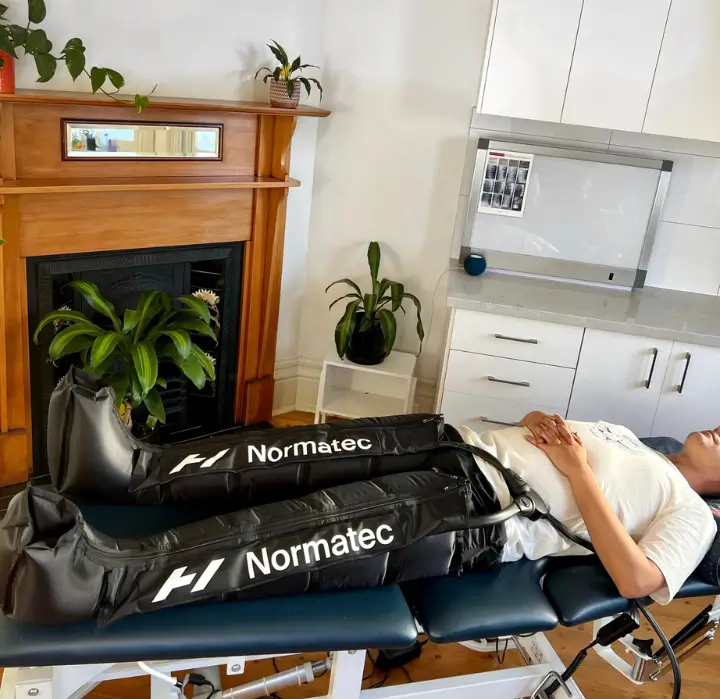
Rated 4.9 stars from 335+ reviews
We’re thrilled to announce receiving hundreds of five-star reviews! While we’d love to share these testimonials, regulations from the Australian Health Practitioner Regulation Agency (AHPRA) prevent us from displaying patient outcomes for regulated services such as Chiropractic, Physiotherapy, Osteopathy, Podiatry, and Acupuncture on this website. To read client feedback, please visit our Google Reviews directly.

Are you ready to transform your run? It’s not just about analysing your run; it’s about revolutionising it!
Whether you’re taking your first strides or sprinting in international competitions, our tailored running assessments, offered by a skilled running physiotherapist, provide the gateway to flawless form and sensational speed.
Why settle for average when you can run extraordinary? Dive into the advantage of having a running physio to guide your stride. Our unique combination of video analysis and biomechanical screening isn’t just high-tech—it’s your secret weapon. By dissecting every detail of your gait, stride, and muscle mechanics, we pinpoint what’s holding you back and why.
Got a kink in your gait? We spot it. Energy leaks? Sealed. Our personalised programs aren’t just about patches; they’re about breakthroughs. From bespoke exercises to expert drills and coaching cues, every piece of advice is tailored to boost your strength, power, and endurance. It’s not just about running longer; it’s about adding life to your miles!
Key Perks of a Central Performance Running Assessment:
Optimised Performance: More than just a quick fix, it’s a comprehensive strategy to make you a powerhouse on the pavement.
Injury Prevention: Every runner’s nemesis, tackled head-on. Your running physiotherapist will fine-tune your form to keep you on track and pain-free.
Normatec Decompression Boots: Run longer, recover faster—experience the power of decompression technology.
State-of-the-Art Techniques: From video playbacks to deep biomechanical insights, experience the cutting edge of running assessments.
Whether you’re jogging in the park or racing against the clock, understanding your running mechanics is pivotal. Don’t let inefficiencies drain your drive. Stop bouncing and start bounding forward with more power and less effort.

Schedule your running assessment today and unleash your potential with confidence speed and endurance.

Every runner has a unique journey. Whether you’re preparing for a casual jog or chasing athletic greatness, your reasons for running and experience levels are personal.
That’s why running assessments start with a thorough conversation about your running history and what you aim to achieve.
This initial conversation allows for a customised approach to meet your specific needs. Looking to take your performance to the next level? The assessment and physio coaching can be tailored to match your goals. Concerned about recurring injuries as your intensity ramps up? The focus will be on refining your gait and designing a training plan that enhances performance while keeping you injury-free.
Many runners have dual objectives: improving performance while avoiding injuries that creep in as intensity or volume increases.
This approach not only fine-tunes running technique but also provides a program that safely pushes your limits.
Ready to run smarter, stronger, and injury-free? Start a journey towards a more effective and enjoyable running experience. Discover how a more personalised physio approach can transform your run today!

Video analysis is an integral part of a running assessment. The physiotherapist utilises Spark Motion Pro, a cutting-edge movement analysis app, to closely examine your running form from both the side and the back. This powerful tool allows the physiotherapist to dissect your gait in detail, identify inefficiencies, suggest improvements, and assess how your running style may contribute to previous or potential injuries.
During the assessment, your run will be filmed on the treadmill, followed by a detailed review of the footage. By drawing lines and highlighting key aspects of your movement, the physiotherapist will help you clearly see what issues are present and discuss the findings in depth.
This process is crucial for understanding the dynamics of your running form, recognising the changes needed, and appreciating the benefits these adjustments can bring.
When runners truly comprehend the reasons behind the recommended changes to their gait, they tend to be more engaged in the process and achieve remarkable results.
Start this insightful journey where analysis is turned into action for running success!

The biomechanical assessment is a fundamental component of your running session, meticulously evaluating strength and flexibility. This assessment identifies muscle imbalances, as well as areas of tightness or weakness that may impact running efficiency, limit performance, or increase the risk of injury.
This critical data is integrated with the video analysis from your treadmill session to understand how these imbalances may be influencing your overall running technique. With this holistic view, a targeted program can be confidently developed to correct any detected imbalances, weaknesses, or restrictions.
By addressing these areas, we aim to enhance your gait swiftly and effectively, helping you achieve a smoother, more powerful run. Join us at Brunswick Health’s running Physio assessment to embark on a journey of tailored improvement that aligns perfectly with your running goals!

Targeted drills and exercises are crucial for refining running technique. The program includes a variety of specific activities designed to enhance key aspects of your run, such as leg cycle, arm movement, and overall stability and control.
From single-leg stance drills to ankling, and dynamic exercises like skipping and plyometrics, each activity is chosen to improve neuromotor control and coordination.
This focus on precise movements helps train your brain to optimise the use of the strength and power developed through your conditioning program. By integrating these exercises, you’ll not only run more efficiently but also move in a way that feels natural and powerful.
Transform your running technique with tailored drills and exercises, and experience the difference in your performance!

A customised training plan is essential for boosting performance and safeguarding against injuries. By carefully considering your current fitness level, running history, injury profile, and specific goals or upcoming races, a plan is designed to perfectly suit your needs.
Training plans are comprehensive, covering everything from the frequency and duration of your runs to the specific types of runs you should focus on—whether it’s base building, recovery, threshold efforts, tempo sessions, or hill repeats.
This tailored approach ensures that every aspect of your training is optimised to improve running efficiency and technique.
For runners at any level, from beginners to elites, having the right training plan is a crucial step toward achieving peak performance and maintaining health.
Customised training plans are designed to not only enhance your capabilities but also help you run smarter and safer. Push your limits while staying injury-free with expert guidance.

Injury prevention is a key component of maintaining a consistent and effective training program for runners at all levels, from recreational to elite. Incorporating injury prevention into your running routine is crucial for long-term success and performance.
Strength training is emphasised as a foundational element for injury prevention. A tailored strength program, designed to meet your specific fitness needs, is essential for any runner looking to stay injury-free. In addition to strength training, enhancing running gait is another effective strategy to reduce injury risks.
Through detailed running assessments, inefficient movement patterns and specific technique issues—like overstriding or a cross-over gait—can be pinpointed, which may increase the risk of injury.
Addressing these issues with a targeted program allows you to adopt a more economical running gait. This adjustment not only improves efficiency but also minimises the load on your body’s tissues, including bones, tendons, muscles, and joints, significantly lowering the risk of injury.
Fortify your running routine to keep injuries at bay, ensuring uninterrupted training and the achievement of your running goals.
Browse our general FAQ for quick answers. For queries specific to a particular service, see the relevant service page.
A professional running assessment is a thorough process designed to optimise performance and minimise the risk of injury.
The assessment starts with a detailed conversation about your running history and goals, laying the foundation for understanding your specific needs and aspirations.
Next, a comprehensive examination of your biomechanics is conducted through video analysis on a treadmill. This allows real-time observation of your running gait to identify any inefficiencies.
Additionally, a biomechanical screen is performed to further evaluate muscle imbalances and movement patterns that may impact your running efficiency.
Based on these insights, a personalised running program is developed to improve your gait and biomechanics. The goal is not only to help you meet your running objectives but also to ensure you remain injury-free as you train.
Experience the benefits of a professional running assessment and elevate your running performance while protecting your body from injury.
To maximise the benefits of your running assessment, it’s important to share your background and current training habits. Here’s what to prepare for discussion during your appointment:
Your Running Experience: Whether you’re a seasoned elite, competitive sub-elite, or dedicated amateur, the approach is tailored to suit your level.
Recent Running History and Training Regimen: Be ready to provide details about your typical mileage, how often you run, your current training schedule, and any recent changes to your routine.
Goals: Share your specific objectives, whether you’re running for fitness, enjoyment, sprint competition, or training for marathons.
Injury History: Bring information about any past or current injuries, including how they have impacted your running.
Appropriate Gear: Bring your running shoes (past and present) and wear comfortable clothing suitable for a running session.
Having this information ready helps create a more effective and personalised assessment that aligns with your needs and aspirations.
After your running assessment, you can progress through the StrideRight running program. This program includes approximately 6 treadmill-based physiotherapy coaching sessions delivered over 8-10 weeks, along with a tailored home exercise program. The home program features specific drills to help strengthen your technique, with coaching cues provided by your physiotherapist to integrate these into your normal runs.
The cost for these sessions is the same as a standard physiotherapy session. For more information on fees, please refer to our fee schedule.
A running assessment is a powerful tool that provides personalised feedback on your running form and gait. By offering detailed insights into how you run, it enables precise, informed adjustments that can significantly enhance performance and reduce the risk of injury.
Utilising both video analysis and a biomechanical screening, a complete understanding of your running mechanics is achieved. This comprehensive approach allows for the development of a targeted coaching program tailored specifically to your needs. With these custom adjustments, you can improve your running efficiency, ensuring smoother, faster, and safer runs.
Experience the transformative benefits of a professional running assessment and take your running to the next level.
Frequently encountered running impairments that can affect performance and increase the risk of injury include:
Regular follow-up sessions are crucial for monitoring progress and making necessary adjustments to your training plan.
These sessions help ensure you stay in top form, continuously improve, and effectively prevent injuries. By regularly evaluating your progress, your program can be fine-tuned to better meet your evolving needs and goals, keeping your training both effective and safe. Stay ahead of the curve and maintain peak performance with expert-guided follow-up sessions.
For runners, certain muscles play pivotal roles not just in movement, but in maintaining stability and efficiency during each stride. The main muscle groups essential for runners include:
Running is a whole-body activity, so while focusing on these specific muscles is important, incorporating compound exercises like squats and lunges is crucial. These exercises enhance coordination and functional movement, integrating muscle strength into running dynamics effectively.
Complementing strength training with plyometric exercises, such as jumping and hopping, can further benefit a runner’s performance. Plyometrics improve the ability to make quick, explosive movements, reducing ground contact time and enhancing running efficiency and economy.
By training your body to leave the ground quickly, you expend less energy, allowing for faster and longer runs.
This holistic approach to training ensures that muscle strengthening translates directly into improved running performance.
Every runner’s gait is as unique as their fingerprint. This uniqueness stems from variations in body structure—height, build, and symmetry—as well as different injury histories, lifestyle factors, and activities outside of running. For example, the natural movement patterns of a 40-year-old desk worker will differ significantly from those of a 20-year-old landscape gardener.
Given these differences, there is no “one-size-fits-all” perfect running gait. Attempting to standardise everyone’s running form can be counterproductive, potentially causing discomfort or injury by forcing movements beyond a person’s mobility or strength capabilities.
This is where the expertise of a seasoned running professional becomes invaluable, blending science with the art of tailored approaches that enhance each runner’s natural style.
Despite individual variations, certain common elements can detract from running efficiency, increase energy waste, and elevate injury risk. These include:
The focus should be on identifying and modifying these inefficient patterns to help you run more effectively, reducing the risk of injury while improving performance. This approach recognises and respects the individuality of each runner, guiding them towards their optimal running form.
The goal is to keep you running even when injured, using a tailored, modified program to accommodate your condition. However, certain severe injuries, such as acute muscle tears or stress fractures, may require a temporary halt to running to ensure proper healing.
As an experienced running physiotherapist, maintaining some level of activity is prioritised whenever possible, as it can facilitate a smoother and quicker return to full running without the need for extensive reconditioning.
This approach is designed to keep you moving toward your goals, even if it means adjusting your training intensity or volume.
Precise testing and structured exercise progressions are employed to manage your return to running in a scientifically sound manner. The ability to perform certain activities, like a single-leg calf raise or hop comfortably, is a key indicator of readiness to resume running. Each runner’s recovery plan is highly individualised based on specific needs and recovery progress, ensuring a safe and effective return to running.
Running assessments conducted by the physiotherapist are priced the same as an initial extended physiotherapy session (allow 45 mins), making them both accessible and affordable. These sessions can also be claimed through private health insurance funds.
HICAPS is available for on-the-spot claims; however, your rebate and eligibility will depend on your individual insurance coverage.
To view our hours and fee schedule, click here.
We are conveniently located in the heart of Brunswick for easy access to all local residents.
Address: 1/68 Melville Road Brunswick, VIC 3055
Areas We Serve
Brunswick, Brunswick West, Brunswick East, Essendon, Moonee Ponds, Parkville, Coburg, Carlton, Fitzroy, Pascoe Vale South, Pascoe Vale, Thornbury, Northcote.

